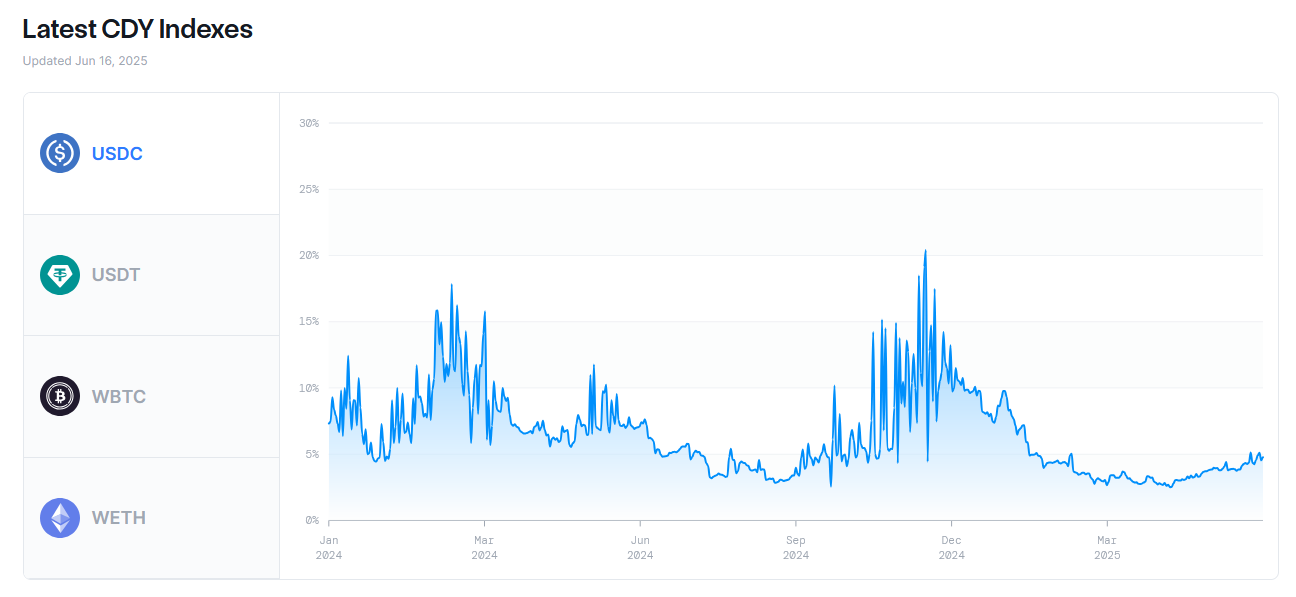Key takeaways
-
Ethereum’s staking yield dropped under 3%, putting it behind many DeFi and RWA protocols.
-
Yield-bearing stablecoins like sUSDe and SyrupUSDC now offer 4–6.5% returns and are rapidly gaining market share.
-
Most competing yield products are built on Ethereum, meaning rising adoption can still strengthen the network’s value over time.
Fixed income isn’t just for TradFi anymore. Onchain yield has become a core pillar of crypto, and Ethereum, the largest proof-of-stake blockchain, sits at the center. Its economy relies on users locking up their ETH (ETH) to help secure the network and, in return, earn a yield.
Yet, Ethereum is not the only game in town. Today, crypto users can access a growing variety of yield-bearing products, some of which compete directly with Ethereum’s staking returns, potentially weakening the blockchain. Yield-bearing stablecoins offer greater flexibility and exposure to traditional finance, with returns tied to US Treasurys and synthetic strategies.
At the same time, DeFi lending protocols expand the range of assets and risk profiles available to depositors. Both often deliver higher yields than Ethereum staking, raising a critical question: Is Ethereum quietly losing the yield battle?
Ethereum staking yield falls
Ethereum staking yield is the return earned by validators for securing the network. It comes from two sources: consensus rewards and execution-layer rewards.
Consensus rewards are issued by the protocol and depend on the total amount of ETH staked. The more ETH is staked across the network, the lower the reward per validator, by design. The formula follows an inverse square root curve, ensuring diminishing returns as more capital enters the system. Execution-layer rewards include priority fees (paid by users to have their transactions included in blocks) and MEV (maximal extractable value), an additional profit earned from optimized transaction ordering. These additional rewards fluctuate based on network usage and validator strategy.
Since the Merge in September 2022, Ethereum’s staking yield has gradually declined. From around 5.3% at its peak, the total yield (including both consensus rewards and tips) now sits below 3%, reflecting the rise in total ETH staked and a maturing network. Indeed, over 35 million ETH, or 28% of its total supply, is now staked.
However, the full staking yield is only accessible to solo validators—those who run their own nodes and lock up 32 ETH. While they keep 100% of the rewards, they also bear the responsibility of staying online, maintaining hardware, and avoiding penalties. Most users opt for more convenient options, such as liquid staking protocols like Lido or custodial services offered by exchanges. These platforms simplify access but charge fees—typically between 10% and 25%—which further reduce the final yield received by the user.
While Ethereum’s sub-3% annual staking yield may seem modest, it still compares favorably to its closest competitor, Solana, where the average network APY currently sits around 2.5% (highest network APY 7%). In real terms, Ethereum’s yield looks even better: its net inflation is just 0.7%, compared to Solana’s 4.5%, meaning stakers on Ethereum face less dilution over time. But Ethereum’s main challenge isn’t other blockchains—it’s the rise of alternative yield-bearing protocols.
Yield-bearing stablecoins gain market share
Yield-bearing stablecoins let users hold a dollar-pegged asset while earning passive income, usually derived from US Treasury bills or synthetic strategies. Unlike traditional stablecoins such as USDC or USDT, which pay no yield to users, these new instruments distribute part of their underlying returns.
The five largest yield-bearing stablecoins—sUSDe, sUSDS, SyrupUSDC, USDY, and OUSG—make up over 70% of the $11.4 billion market, and use different methods to generate yield.
Issued by Ethena, a BlackRock-backed company, sUSDe relies on a synthetic delta-neutral strategy involving ETH derivatives and staking rewards. It has delivered some of the highest yields in crypto, with historical rates ranging from 10% to 25% APR. While current yields have declined to around 6%, sUSDe still outpaces most competitors, though it comes with elevated risk due to its complex, market-dependent strategy.
sUSDS, developed by Reflexer and Sky (ex-MakerDAO), is backed by sDAI and RWAs (tokenized real-world assets). Its yield is more conservative—currently 4.5%—with a focus on decentralization and risk mitigation.
Issued by Maple Finance, SyrupUSDC routes yield through tokenized Treasurys and MEV strategies. It offered double-digit returns at launch but now yields 6.5%, still higher than most centralized alternatives.
USDY, issued by Ondo Finance, tokenizes short-term Treasurys and yields 4.3%, targeting institutions with a regulated, low-risk profile. OUSG, also from Ondo, is backed by BlackRock’s short-term Treasury ETF and offers a yield around 4%, with full KYC requirements and a strong compliance focus.

The key differences across these products lie in their collateral (synthetic vs. real-world), risk profile, and accessibility. sUSDe, SyrupUSDC, and sUSDS are fully DeFi-native and permissionless, while USDY and OUSG require KYC and cater to institutional users.
Yield-bearing stablecoins are rapidly gaining traction, combining the stability of the dollar with yield opportunities once reserved for institutions. The sector has grown by 235% over the past year, and with increasing demand for onchain fixed income, it shows no signs of slowing down.
Related: TradFi’s deep liquidity issue is crypto’s silent structural risk
DeFi lending is still centered on Ethereum
Decentralized lending platforms like Aave, Compound, and Morpho let users earn yield by supplying crypto assets to lending pools. These protocols set rates algorithmically based on supply and demand. When demand for borrowing rises, so do interest rates, making DeFi lending yields more dynamic—and often uncorrelated with traditional markets.
The Chainlink DeFi Yield Index, which tracks average lending returns across major platforms, shows stablecoin lending rates typically hover around 5% for USDC and 3.8% for USDT. Yields tend to spike during bull markets or speculative frenzies—like in February–March and November–December 2024—when borrowing demand soars.

Compared to banks, which adjust rates based on central bank policy and credit risk, DeFi lending is market-driven. This creates opportunities for higher returns, but also exposes lenders to unique risks, such as smart contract bugs, oracle failures, price manipulation, and liquidity crunches.
Yet paradoxically, many of these very products are built on Ethereum itself. Yield-bearing stablecoins, tokenized Treasurys, and DeFi lending protocols largely rely on Ethereum’s infrastructure, and in some cases, incorporate ETH directly into their yield strategies.
Ethereum remains the most trusted blockchain among both traditional and crypto-native finance players, and it continues to lead in hosting DeFi and RWAs. As these sectors gain adoption, they drive up network usage, boost transaction fees, and indirectly reinforce ETH’s long-term value. In this sense, Ethereum may not be losing the yield battle—it may simply be winning it differently.
This article does not contain investment advice or recommendations. Every investment and trading move involves risk, and readers should conduct their own research when making a decision.
Read the full article here








